The basic line chart widget allows you to customize the chart style, the display of different series of data, and other options as needed.
Style
- Global Settings
- Font Family: To set the font of the displayed text, select the target font from the drop-down list. The default font is Microsoft YaHei.
- Margin: Spacing between the chart and the chart borders. The unit is pixels.
- Empty Data: If you select this check box, the line and the x-axis intersect at the point where
the value corresponding to the y-axis is 0. If you clear this check box, the line
and the x-axis do not intersect at the point where the value corresponding to the
y-axis is 0.
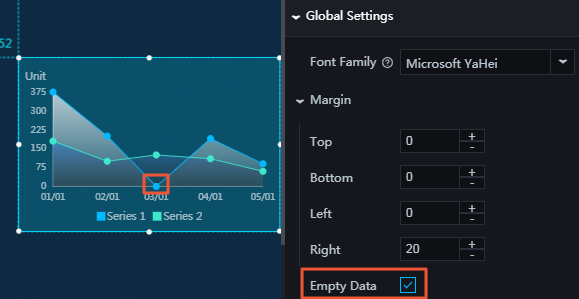
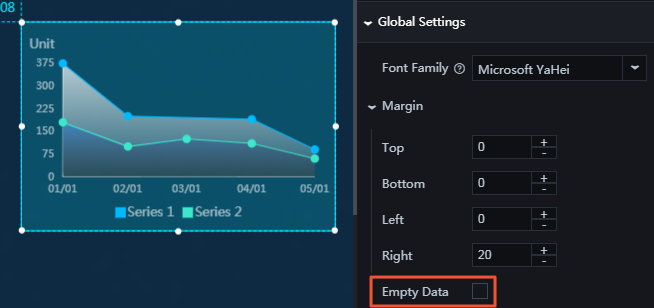
- X Axis: To display the x-axis, click the Eye icon.
- Text Style
- Font Size: To change the font size of the text along the x-axis, enter a value, or click + or –.
- Font Color: To change the font color of the text along the x-axis, see Color picker.
- Font Weight: To set the font weight of the text along the x-axis, select the target font weight from the drop-down list.
- Axis Label: To display the axis labels, click the Eye icon.
Note An error will be displayed if the data format differs from the data format set for the x field in the data pane.
- Data Type: To set the data type along the x-axis, select the target type from the drop-down
list.
- Numeric
- Category
- Time
- Data Format: To set the format of the data, select the target format from the drop-down list.
Note The following is an example: %Y/%m/%d%H:%M:%S.
- Display Format: To set the display format of the data, select the target format from the drop-down
list.
Note Time format: %m/%d%Y%H:%M:%S; integer format: d; floating-point number: .1f.
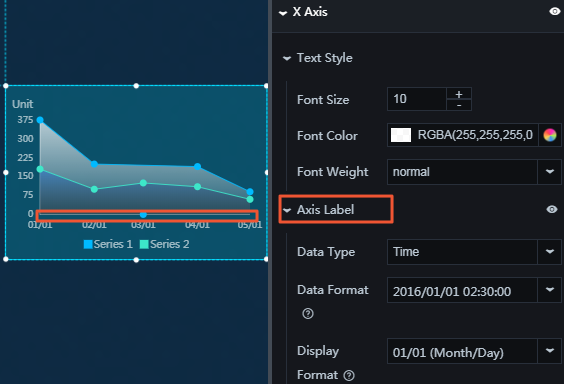
- Margin: If you select this check box, spacing 1 (spacing between the chart and the y-axis) and spacing 2 (spacing between the chart and the right border of the chart) are displayed. If you clear this check box, spacing 1 and spacing 2 are not displayed.
- Margin Size: To adjust spacing 1 and spacing 2, enter a value or drag the slider. The value range
is from 0 to 1.

- Min/Max: You can set the minimum and maximum values along the x-axis as needed.
- Offset: To adjust the spacing between the labels along the x-axis, enter a value, or click + or –.
- Unit: You can customize the unit of the text along the x-axis as needed.
- Quantity: To change the number of x-axis labels, enter a value, or click + or –.
- Angle: To set the angle of the x-axis labels, select the target angle from the drop-down
list. The options include horizontal, slant, and vertical.
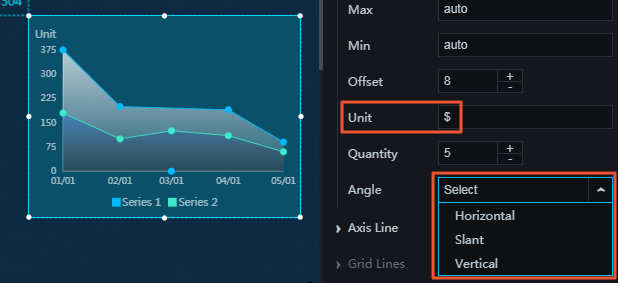
- Axis Line: To display the axis line, click the Eye icon. To change the color of the axis line, see Color picker.
- Grid Lines: To display the grid lines, click the Eye icon. To change the color of the grid lines, see Color picker.

- Data Type: To set the data type along the x-axis, select the target type from the drop-down
list.
- Text Style
- Y Axis
For more information about how to set the y-axis, see X Axis.
- Legend: To display the legend items, click the Eye icon.
- Text Style
- Font Size: To change the font size of the legend text, enter a value, or click + or –.
- Font Color: To change the font color of the legend text, see Color picker.
- Font Weight: To set the font weight of the legend text, select the target font weight from the drop-down list.
- Layout
- Margin
- Horizontal Interval: To adjust spacing 1 (spacing between the legend items and the right border of the chart) and spacing 2 (spacing between the legend items and the left border of the chart), enter a value, or click + or –. The setting takes effect only when two or more series are set.
- Vertical Interval: To adjust spacing 1 (spacing between the legend items and the top border of the chart) and spacing 2 (spacing between the legend items and the bottom border of the chart), enter a value, or click + or –.
- Position: To set the position of the legend items, select the target position from the drop-down
list.
- Top center
- Top left
- Top right
- Bottom center
- Bottom left
- Bottom right

- Margin
- Text Style
- Series: To add or delete a series, click + or click the Trash icon.
Note A series is an array. You can set two or more series as needed, and the Editor traverses and renders the data through the series settings. To set data in a specific format, sort the data manually.
- Series Name: You can set a name for the series as needed. If the series does not have a name,
the value of the s field is displayed as the series name. If the s field does not exist, the value null is used.
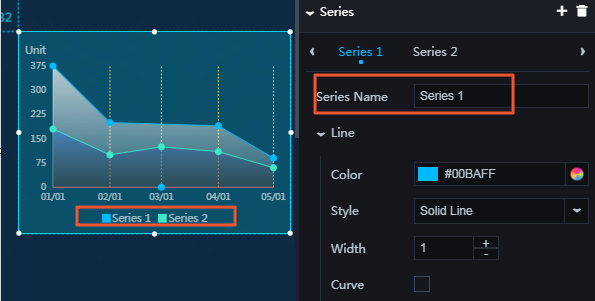
- Line
- Color: To change the line color, see Color picker.
- Style: To set the line style, select the target style from the drop-down list.
- Solid line
- Dotted line
- Width: To change the line width, enter a value, or click + or –.
- Curve: If you select this check box, the line is displayed as a curve. If you clear this
check box, the line is displayed as a straight line.

- Point Style: To display the point style, click the Eye icon.
- Color: To change the point color of the line, see Color picker.
- Radius: To change the point radius, enter a value, or click + or –.
- Area: To set the fill color type, select the target type from the drop-down list.
- Solid fill
- Gradient fill
- You can select two colors as the gradient colors.
- To change the gradient angle, enter a value or drag the slider. The value range is from 0 to 360.
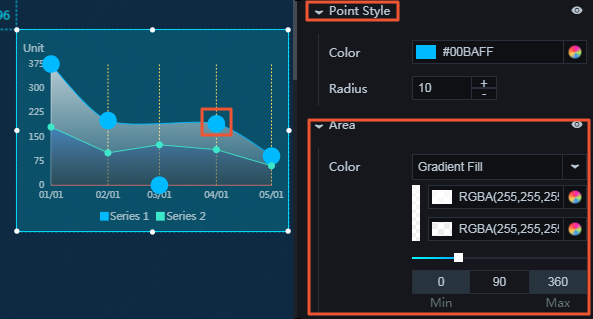
- Label: To display the labels, click the Eye icon.
- Font Size: To change the font size of the label text, enter a value, or click + or –.
- Color: To change the font color of the label text, see Color picker.
- Font Weight: To set the font weight of the label text, select the target font weight from the drop-down list.

- Series Name: You can set a name for the series as needed. If the series does not have a name,
the value of the s field is displayed as the series name. If the s field does not exist, the value null is used.
- Animation: To display the animation option, click the Eye icon.
- Original Duration: To change the duration to which the widget renders the animation for the first time, enter a value, or click + or –. The unit is milliseconds.
- Easing: To set animation easing, select the target effect from the drop-down list.
- Duration for Data Update: To change the animation duration when data changes, enter a value, or click + or –. The unit is milliseconds.
- Update from Latest Status: If you select this check box, the animation begins from the point where the data has changed. If you clear this check box, the animation begins from the starting point.

Data
- x: data along the x-axis. The value of this field must be in the same format as the label text along the x-axis.
- y: data along the y-axis
- s: (optional) series value. If the Series Name field in Series does not have a value, the value of the s field is displayed as the series name.
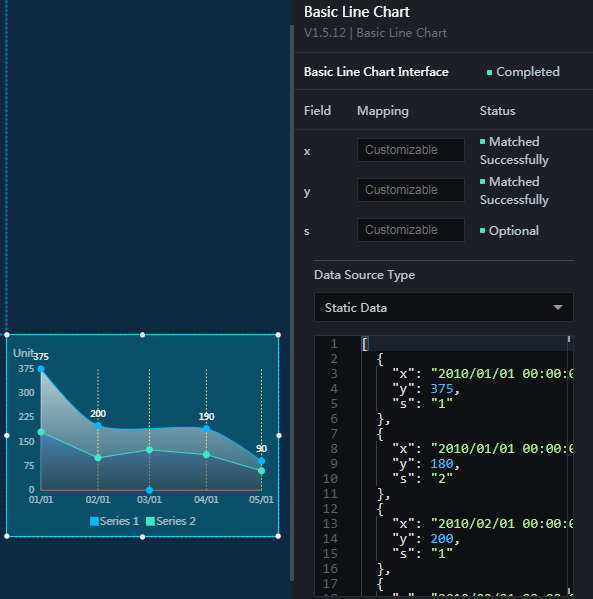
Example: The following example describes how to configure the monthly evaporation and rainfall
data obtained from January to July:
- In the Series area, click Series 1 and set Series Name to Evaporation. Click Series 2 and set Series Name to Rainfall, as shown in the following figures.
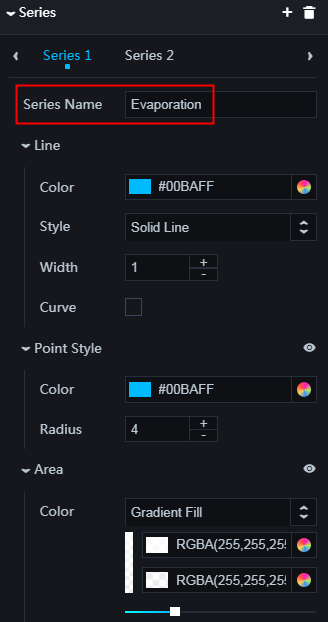
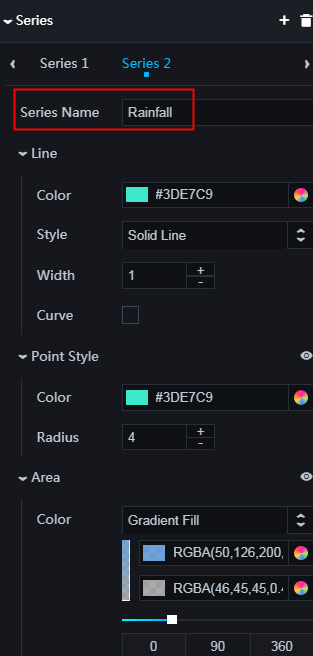
- Set the type of data along the x-axis, as shown in the following figure.
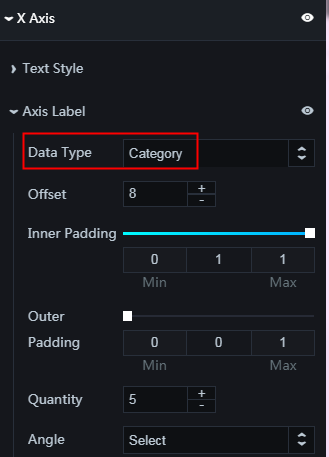
- Set the display format of data along the y-axis, as shown in the following figure.

- In the data pane, set Data Source Type to Static Data and configure data as follows:
[ { "x": "January", "y": 2, "s": 1 }, { "x": "January", "y": 2.6, "s": 2 }, { "x": "February", "y": 4.9, "s": 1 }, { "x": "February", "y": 5.9, "s": 2 }, { "x": "March", "y": 7, "s": 1 }, { "x": "March", "y": 9, "s": 2 }, { "x": "April", "y": 23.2, "s": 1 }, { "x": "April", "y": 26.4, "s": 2 }, { "x": "May", "y": 25.6, "s": 1 }, { "x": "May", "y": 28.7, "s": 2 }, { "x": "June", "y": 76.7, "s": 1 }, { "x": "June", "y": 70.7, "s": 2 }, { "x": "July", "y": 135.6, "s": 1 }, { "x": "July", "y": 175.6, "s": 2 } ]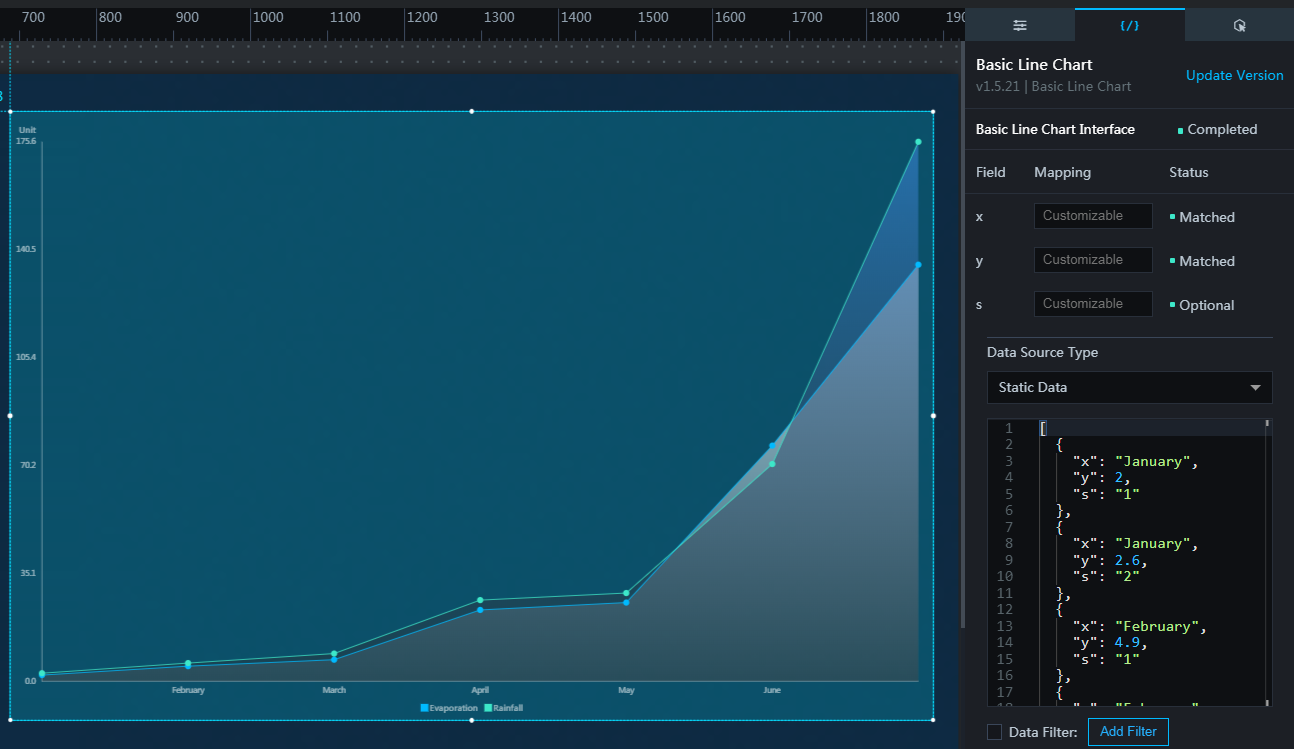 The data can be obtained from a CSV file, as shown in the following figure.
The data can be obtained from a CSV file, as shown in the following figure.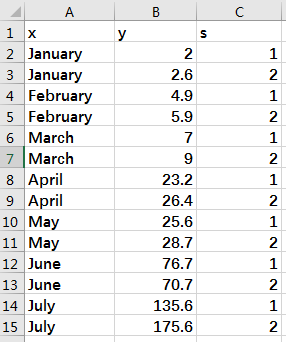
In the CSV file, x, y, and s in the first row are the fields, and values in the second and subsequent rows are the field values. To download the CSV file, click CSV file.
Interaction
This widget is not connected to any events yet.